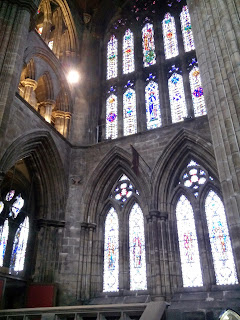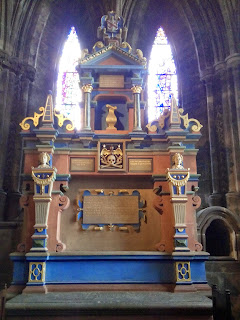The first of my posts to venture outside London relates to the Second City of Empire - Glasgow. (Birmingham and Liverpool both claim that title, it should be noted. Naturally, I am biased...). Strictly speaking Glasgow Cathedral is not a cathedral at all, as it hasn't been the seat of a bishop for many years.
Begun in the first half of the 12th Century, in the reign of David I, at the top of the High Street, it is also known as the High Kirk of Glasgow, St. Kentigern's or St. Mungo's Cathedrals (Kentigern and Mungo are different names for the same person - Glasgow's patron saint. He is buried in the lower church which sits beneath the main body of the cathedral).
Glasgow University was founded in its precincts in 1451. (It moved across the road a decade later, before finally settling in its current location in the West End on Gilmorehill).
Before the Reformation it was the seat of first the Bishop of Glasgow and then the Archbishop of Glasgow. The Roman Catholic Archbishop of Glasgow now has his seat at St. Andrew's Cathedral, and Glasgow Cathedral is now a Presbyterian place of worship.
Architecturally, the building is Gothic. As you wander round the exterior, you will see that much of the stone work is still blackened as a result of the city's industrial past.
 |
| The exterior of the chapel known as the Blacader Aisle. |
In the main body of the cathedral are many monuments to Scotland's military past - be they Scottish regiments or individual soldiers. There is a wealth of stained glass throughout - some relating to the St Mungo, and others to Glasgow's industrial and mercantile past. These are Victorian or later.
Some views of the nave, aisle and choir.
Off the west side of the cathedral is the Blacader Aisle, a small white-painted chapel. It was constructed around 1500 by Archbishop Blacader (also spelt as Blackadder).
The lower church was built in the 13th Century. At one point, after the Reformation, three separate congregations met in the cathedral. The Outer High in the nave, the Inner High in the Quire (Choir) and the Barony in the lower church. It is in the lower church that St. Mungo's tomb can be seen.
Down here is a monument to some Covenanters - Protestant martyrs of the reign of Charles II and his brother James (VII of Scotland and II of Great Britain).
If you wander around the graveyard of the cathedral one word stands out more than any other on the weathered tombstones - Merchant - as befits a mercantile city. Many more businessmen and their families are buried in the nearby Necropolis (subject of another post to come). The cathedral sits very close to the city's Royal Infirmary, so there are a few physicks as well.
 |
| That's the Necropolis on the hill in the background. |
Glasgow is the only mediaeval cathedral in Scotland to have survived physically intact since the Reformation. It is owned by the Crown, and managed by Historic-Scotland.
The city's coat of arms features a bird, a fish, a tree and a bell. These relate to four miracles that the 6th Century Saint Mungo is supposed to have been responsible for. There is a verse to go with them:
Here is the bird that never flew
Here is the tree that never grew
Here is the bell that never rang
Here is the fish that never swam
The bird refers to a robin which he is supposed to have brought back to life after it was killed by some of his school friends. The tree refers to him restarting a fire that had gone out (when he was supposed to be tending it) using a hazel branch. The bell was brought back to Glasgow by Mungo from Rome, which was used in services for the dead. (The original was lost and a copy made in 1640). The fish relates to his most famous miracle, when he helped Queen Languoreth of Strathclyde who had been accused of adultery. She was alleged by her husband, King Riderich, of having given her lover her ring, and he demanded to see it. In reality, Riderich had stolen it and thrown it into the Clyde. Languoreth turned to Mungo for help. He sent his companions out to catch a fish and the ring was found in the salmon they landed and returned to the Queen. It should be noted that very similar tales have been attributed to a number of saints.
Mungo was born in Fife, supposedly of royal birth (his mother was thrown into the sea by her father after she became pregnant after being raped). She did not drown, so her father cast her adrift instead in a coracle which came to rest in Fife.
Mungo was a contemporary of Saint David (patron saint of Wales) with whom he stayed for a time. He did not die a martyr's death. Rather, in old age, he expired in his bath.
Scots author J K Rowling named the wizards' hospital after him in her Harry Potter books.
























No comments:
Post a Comment